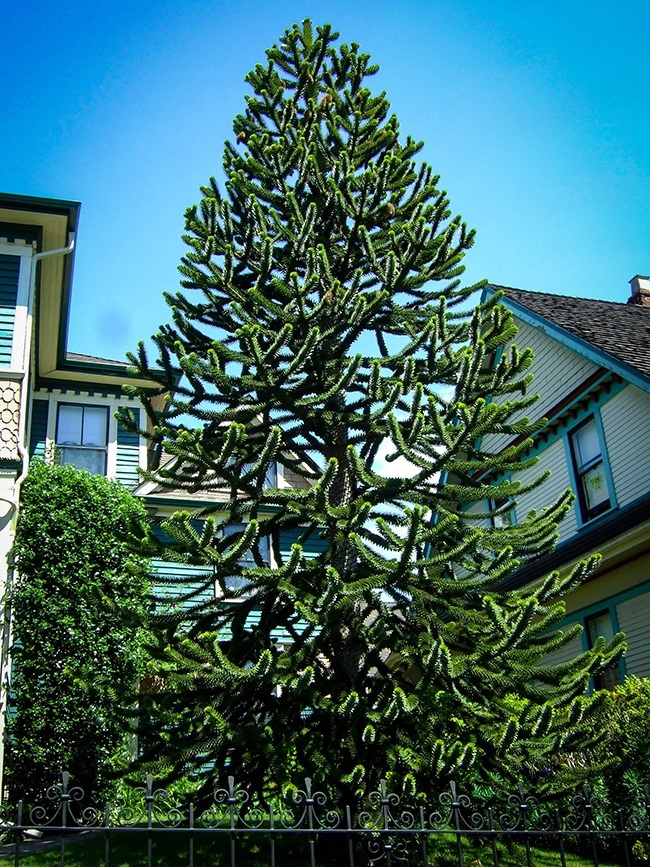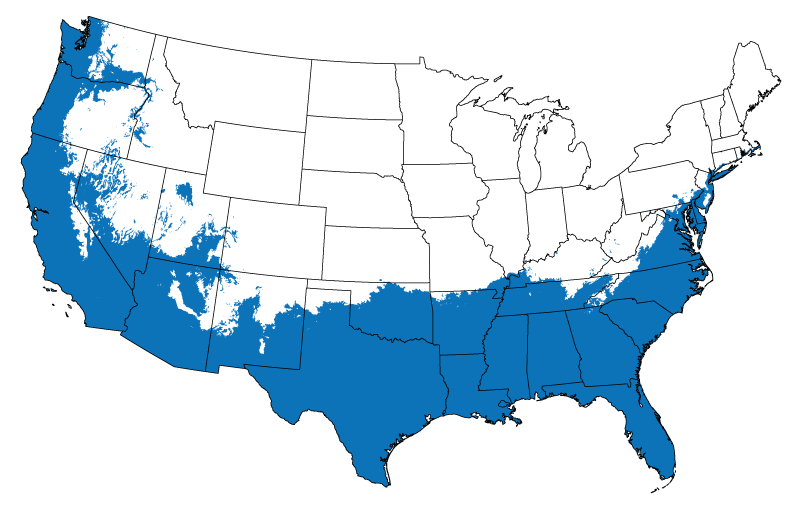Monkey puzzle tree дерево
An ancient and curious tree, the Chilean Pine has been fascinating people for generations. Of course you might be wondering what a Chilean Pine is – it’s best known by the name Monkey Puzzle Tree, which itself is something of a conundrum as there are no monkeys in its natural habitat.
The monkey puzzle tree is most at home clinging to the sides of mountains, particularly volcanoes. What’s particularly interesting about this is that the bark of the tree is resistant to fire, meaning clusters of them can actually survive lava flows. Usually found at around 3,300 feet above sea level and higher, this gives a good indication of the type of conditions the tree prefers – although, in good news for gardeners, it is not especially picky. The monkey puzzle tree is usually happiest in well drained and slightly acidic soil, with volcanic soil being the best. This said they are remarkably unfussy and can be grown in domestic gardens without much difficulty, just as long as you’re not affected by high levels of pollution. They don’t take kindly to it.
Plant one in the right spot, though, and you’re in for a treat. The monkey puzzle has a lot of growth potential. Many conifers can reach skywards dramatically and this one is no exception, with mature heights of 40m (130ft) not uncommon, but it does take a while to get there. These are slow growing trees, that are unlikely to even start fruiting before 20 years of age, but they make up for it with a very long lifespan; when you plant one in your garden you are planting a tree that will last for generations – anything up to a thousand years. The species itself is even more long-lived; these remarkable plants have been around for 200million years. Its spiny leaves are thought to have evolved to protect the tree from grazing dinosaurs, which is perhaps why we are lucky enough to still have them gracing our landscapes today.
Like many conifers the monkey puzzle bears cones on distinct male and female trees, but infrequently some trees will produce both sexes of fruit. The male cones take up to two years to mature and are almost five inches long when ready to release their pollen. Cylindrical in shape and resembling a burnished red cucumber, they are easy to tell apart from their female counterparts which appear a year and a half after pollination. These are very large and globular, and by the time they’re ready to release their two-inch seeds these pods are almost eight inches in diameter. Each female cone will release 200 seeds into the environment as the casing breaks down and disintegrates.
With seed numbers like this you might imagine that the monkey puzzle tree would have no trouble surviving. Sadly this is not the case, and in 2013 they were declared an endangered species. This is due mostly deforestation and the desirable commercial qualities of their wood. Although commercial felling of these trees was banned in 1990, there are still cases of illegal logging reported today. The seeds have long been used as a food source and this practice has also impacted the trees’ ability to survive. As if these problems weren’t troublesome enough a vast number of trees have been destroyed in forest fires, including many in the early 21 st century. This might be surprising given their ability to withstand lava flows but it is the bark itself that is resistant, and thanks to their oil rich leaves they burn relatively easily if the fires are large enough. Sadly, national parks that suffered large fires lost some ancient specimens that were over 1,300 years old. However there are planting projects underway that should prevent further decline.
It seems only right to end by answering the question of how the tree came by its familiar name. The natives of Chile call it Pehuén, and for those people it is a sacred tree. It was discovered by western biologists in the 1790s and not long afterwards examples were being planted in English gardens. One proud owner was Sir William Molesworth, who grew a fine specimen at his Cornish home, Pencarrow House. On looking at its striking spiked leaves his friend Charles Austin remarked, “It would puzzle a monkey to climb that.” Mr Austin’s comment stuck, and that’s how the monkey puzzle tree got its name.
Источник
How to Identify and Care for a Monkey Puzzle Tree
Steve Nix is a member of the Society of American Foresters and a former forest resources analyst for the state of Alabama.
Monkey-Puzzle Tree is a wild, «scary» evergreen with open splaying and spiraling branches. The tree can grow to 70 feet tall and 30 feet wide and forms a loose, see-through, pyramidal shape with a straight trunk. The tree is so open you can actually look through it.
The leaves are dark green, stiff, with sharp needles that cover the limbs like armor. Monkey-Puzzle tree makes an attractive, novelty specimen for large, open yards. It is seen in large numbers in California.
Specifics
- Scientific name: Araucaria araucana
- Pronunciation: air-ah-KAIR-ee-uh air-ah-KAY-nuh
- Common name(s): Monkey-Puzzle Tree or Puzzle Tree
- USDA hardiness zones: 7b through 10
- Origin: Chile (national tree) and the Andes of South America.
- Uses: garden specimen; indoor tree specimen
- Availability: somewhat available, may have to go out of the region to find the tree.
Monkey Puzzle’s Range
There are no native monkey puzzle trees in the United States. The natural monkey puzzle tree is now found in two small areas in the Andes and on the coastal mountain range. It is a highly fire-adapted species, occurring in an area where fires have long been caused by volcanic activity and, since the early Holocene, by humans.
The tree can grow in North America along the coastal zone from coastal Virginia, down the Atlantic, west through Texas and up the Pacific coast to Washington.
Description
Dr. Mike Dirr in Trees and Shrubs for Warm Climates says:
«The habit is pyramidal-oval in youth, later with a slender bole and ascending branches near the top. cones are about twice the size of hand-grenades and hurt even worse. Tolerates extremes of soil, except permanently moist.»
Etymology
The origin name Monkey-puzzle derives from its early cultivation in Britain in about 1850. The tree was very popular in Victorian England. Legend has it that an owner of a young tree specimen in Cornwall was showing it to a group of friends, and one made the remark, «it would puzzle a monkey to climb that».
The popular name became, first ‘monkey-puzzler’, then ‘monkey-puzzle’. Prior to 1850, it had been called Joseph Bank’s Pine or Chile Pine in Britain even though it is not a pine.
Pruning
The Monkey Puzzle needs to be isolated from other trees for the best display of its graceful and natural limb sweep. Maintain a central leader and do not top for best effect. Branches should be protected and only pruned if dead wood appears. Dead branches are hard to work on but will cause the tree to decline if not removed.
Monkey Puzzle in Europe
Monkey-puzzle was introduced to England by Archibald Menzies in 1795. Menzies was a plant collector and naval surgeon on Captain George Vancouver’s circumnavigation of the globe. Menzies was served the seeds of the conifer as a dessert while dining with the governor of Chile and later sowed them in a frame on the ship’s quarterdeck. Five healthy plants made it back to Great Britain and were the first plants to be planted.
Culture
- Monkey puzzle tree does best where the summers are cool and humid, and they are popular landscape oddities in England.
- Light: Full sun to partial shade.
- Moisture: Likes a moist, but well-drained soil and regular watering.
- Propagation: By seeds or by tip cuttings from vertical shoots. Cuttings from lateral-growing shoots will develop into sprawling shrubs.
In-Depth Description
Monkey-puzzle prefers well-drained, slightly acidic, volcanic soil but will tolerate almost any soil type provided drainage is good. It prefers temperate climates with abundant rainfall, tolerating temperatures down to about −20 °C. It is far and away the hardiest member of its genus and the only one that will grow in mainland Britain, or in the United States away from the extreme south.
In Canada, Vancouver and Victoria have many fine specimens; it also grows on the Queen Charlotte Islands. It is tolerant of salt spray but does not like exposure to pollution. It is a popular garden tree, planted for its unusual effect of the thick, ‘reptilian’ branches with a very symmetrical appearance.
The seeds are edible, similar to large pine nuts, and are extensively harvested in Chile. A group of six female trees with one male for pollination could yield several thousand seeds per year. Since the cones drop, harvesting is easy. The tree, however, does not yield seeds until it is around 30-40 years old, which discourages investment in planting orchards.
Источник


:max_bytes(150000):strip_icc()/GettyImages-986353206-5c4bc21646e0fb0001ddde6b.jpg)